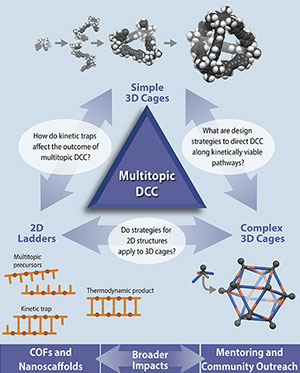Designing New Macromolecular Architectures
Form Follows Function: Shape-Persistent, Macromolecular Products of Known Structure
The phrase “form follows function,” initially coined to describe architectural design, is a principle which states that the shape of a building should be related to its desired function. In the Moore Group, this phrase is used in a similar matter, albeit to describe shape-persistent structures of nanoscale dimension. Since the early 1990’s, the Moore Group has been interested in phenylacetylene-based shape-persistent, macromolecular architectures of nanoscale dimensions with known structure. We hypothesized that these molecules are building blocks for nanoporous materials, capable of infusing well-defined void volumes into solids. A molecularly-designed approach to nanoporous solids provides a programmable way to tune functional materials properties.
Our synthetic proficiency in this area has led to the preparation of various nanostructures including foldamers, dendrimers, macrocycles, and molecular cages, all of which have found use in a variety of interesting applications. While earlier work utilized step-wise coupling reactions to build up chemical constituents in a convergent fashion, our current synthetic approach involves the use of dynamic alkyne metathesis (AM). This powerful method enables the one-step construction of 2D and 3D molecular architectures in high yields and on gram scales.
Building on our previous work, current research efforts on this topic are targeted at three specific challenges: 1) Rational design of complex nanostructures via dynamic AM, including structures having reduced symmetry, 2) Elucidating the relationship between molecular structure and macroscopic properties, and 3) Utilizing these unique nanostructures for various materials applications. Through collaborative efforts with researchers at the University of Illinois Chemistry Department, the Beckman Institute for Advanced Science and Technology, and others, we have actively pursued these targeted challenges. We believe that our results will help streamline the process of designing molecular nanostructures for desired materials applications.

